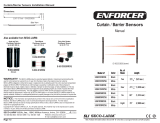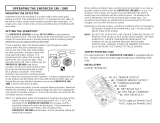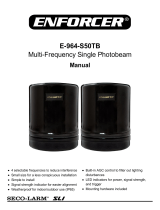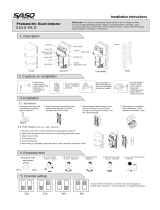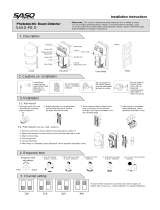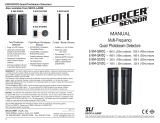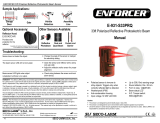Page is loading ...

Manual
* Special order only (E-964-D390Q is a multi-frequency version).
SECO-LARM
12
NOTICE: The information and specifications printed in this manual are current at the time of publication. However, the
SECO-LARM policy is one of continual development and improvement. For this reason, SECO-LARM reserves the right to
change specifications without notice. SECO-LARM is also not responsible for misprints or typographical errors.
Copyright © 2016 SECO-LARM U.S.A., Inc. All rights reserved. This material may not be reproduced or copied, in whole or in
part, without the written permission of SECO-LARM.
SECO-LARM
®
U.S.A., Inc. U.S.A., Inc.
U.S.A., Inc. U.S.A., Inc.
U.S.A., Inc.
16842 Millikan Avenue, Irvine, CA 92606
Tel: 800-662-0800 / 949-261-2999 Fax: 949-261-7326
Website: www.seco-larm.com
E-mail: sales
@
seco-larm.com
WARRANTY: This SECO-LARM product is warranted against defects in material and workmanship while used in normal
service for a period of one (1) year from the date of sale to the original consumer customer. SECO-LARM’s obligation is
limited to the repair or replacement of any defective part if the unit is returned, transportation prepaid, to SECO-LARM.
This Warranty is void if damage is caused by or attributed to acts of God, physical or electrical misuse or abuse, neglect,
repair, or alteration, improper or abnormal usage, or faulty installation, or if for any other reason SECO-LARM determines that
such equipment is not operating properly as a result of causes other than defects in material and workmanship.
The sole obligation of SECO-LARM, and the purchaser’s exclusive remedy, shall be limited to replacement or repair only, at
SECO-LARM’s option. In no event shall SECO-LARM be liable for any special, collateral, incidental, or consequential personal or
property damages of any kind to the purchaser or anyone else.
file:MI_E96x-DxxxGQ_160218.pmd
PITSW3
Also available from SECO-LARM:
Twin Photobeam Detectors
®
Reflective
Photobeam Sensor
Hooded Reflective
Photobeam Sensor
Flush-Mount
Photobeam Sensors
•
2, 4, 6, 8 or 10 Beams available
(10 Beams - curtain sensor only)
•
Curtain sensor - Up to 50ft (15m)
•
Barrier sensor - Up to 393ft (120m)
•
Weatherproof
•
Adjustable interruption time
•
Available with 45ft (14m) or
35ft (11m) range
•
Weatherproof
•
Mounting hardware included
•
Reflector included
•
UL325 - 2016 compliant
•
Available with 50ft (15m) or
33ft (10m) range
•
Weatherproof
•
Polarized version available
•
Round reflector included
•
UL325 - 2016 compliant
•
Available with reflective beam and
16ft (5m) range or through-beam
and 33ft (10m) range
•
Adjustable alignment angle
•
Mounts to a single-gang box
®
Note: All above models are also available as non-ETL compliant versions.
E-960-D90GQ 90 ft. (30m) 190 ft. (60m)
E-960-D190GQ* 190 ft. (60m) 390 ft. (120m)
E-960-D290GQ* 290 ft. (90m) 590 ft. (180m)
E-964-D390GQ* 390 ft. (120m) 790 ft. (240m)
Model # Outdoor Range Indoor Range
Curtain / Barrier
Sensors
Twin Photobeam
Sensors
•
Up to 390ft (120m) range
•
Laser-beam alignment
•
Weatherproof
•
Anti-frost system
•
Adjustable response time
Quad Photobeam
Detectors
•
4 Models available - up to
660ft (200m) range
•
Weatherproof
•
12~24 VAC/VDC
•
Laser-beam alignment

2
TABLE OF CONTENTS
Important ................................................... 2
Choosing a Location ................................... 3
Typical Installations ....................................... 4
Running the Cable ........................................... 4
Wiring the Transmitter – Wall Mount ................ 4
Wiring the Transmitter – Pole Mount ................ 5
Wiring .............................................................. 5
Examples of Ways To Connect Sensors ............. 6
Selectable 4-channel Beam Frequency ............ 7
Beam Frequency Selection Chart...................... 7
(E-964-D390GQ Model Only)
Multiple Sensors Sample Applications ......... 7-8
Adjusting the Alignment ................................. 9
Testing the Unit .............................................. 10
Specifications ................................................ 10
Dimensions .................................................... 11
Troubleshooting .............................................. 11
IMPORTANT
–
Do not connect to power until the sensor is completely installed and the
installation has been double-checked.
Included:
Transmitter x 1 Receiver x 1 Mounting plates x 2
Mounting
hardware
also
included.
Pole mounting
brackets (2 sets)
Features:
●
Four selectable beam frequencies
(For E-964-D390GQ model only).
●
Twin beams provide reliable perimeter
security, minimizing false alarms from
falling leaves, birds, etc.
●
Lensed optics reinforce beam strength
and provide excellent immunity to false
alarms due to rain, snow, mist, etc.
●
Weatherproof, sunlight-filtering
case for indoor and outdoor use.
●
Non-polarized power inputs.
●
Automatically adjusts beam
strength to compensate for
different weather conditions
●
Automatic input power filtering with
special noise rejection circuitry.
●
NC/NO trigger output.
●
N.C. tamper circuit included.
●
Quick, easy installation with built-
in laser beam alignment system.
11
Top View
43ST Pole Size
Side View
2.8” (72mm)
Fig. 11: Dimensions
Situation
Transmitter LED does not light.
Receiver LED never lights up
when the beam is interrupted.
Beams interrupted and LED
lights, but no trigger output.
Trigger LED continuously lit.
Trigger becomes erratic in bad
weather.
Frequent false triggers from
leaves, birds, etc.
Solution
Ensure the power supply to the
transmitter is 12 to 30V DC/AC, 60Hz.
a. Double-check the voltage.
b. Clean the cover.
c. Check overall installation.
Check the continuity of the wiring
between the sensor and the alarm.
a. Realign the lenses.
b. Remove any obstacles.
c. Clean the cover.
Check overall system installation.
If still erratic, realign the lenses.
a. Reduce the response time.
b. Change the transmitter and/or
location.
Table 6: Troubleshooting
Possible Problem
Incorrectly wired and/or
insufficient voltage
a. Insufficient voltage
b. Beam reflected away from receiver
c. Beams not simultaneously interrupted.
Trigger cable may be cut, or the
relay contact stuck due to overloading.
a. Lenses out of alignment.
b. Beams are blocked.
c. Cover is foggy or dirty.
Lenses out of alignment.
a. Too sensitive.
b. Bad location.
Rear View
Front View
2.9” (74mm)
6.8” (173mm)
Fig. 12: Beam Spread
distance (d)
beam spread (s)
The beam spread (s) can be calculated as s=0.03xd.
Distance (d)
Beam spread (s)
90ft (30m)
190 ft (60m)
290 ft (90m)
390 ft (120m)
2.7 ft (0.8m)
5.7 ft (1.7m)
8.7 ft (2.7m)
11.7 ft (3.6m)

Note: Depending on the monitoring system used by the gate motor, it may be necessary to use either
the N.C. output or connect the included 10k
Ω
resistor to the N.O. or N.C. output. Please refer to
the gate operator manual or the gate operator manufacturer for the preferred monitoring method.
1. Power up the transmitter and receiver.
2. If the yellow or red LED remains steady ON
even when the beam is not interrupted, re-
adjust the alignment.
3. Walk between the transmitter and receiver to
interrupt the beams. Walk at various speeds,
and adjust the delay time adjustment knob as
needed.
Testing the Unit
NOTE – The sensor will be triggered only if both the
upper and lower beams are simultaneously
interrupted.
IMPORTANT – Test the detector periodically to
ensure the alignment settings are
suitable for the site.
3
Side Views
Top Views
32" to 39"
Vertical adjustment
Horizontal adjustment
±90°(180°)
±5°
(10°)
Fig. 2: Vertical and Horizontal Adjustments Fig. 3:Typical Installations
Vertical
adjustment
screw
Choose a Location
To prevent erratic operation and/or false alarms:
• Wind will not directly cause false alarms, but could cause leaves or similar objects to fly or wave
into the beams. Therefore, do not mount near trees, bushes, or other leafy vegetation.
• Do not mount where the transmitter or receiver could be splashed by water or mud.
• Do not mount where the unit could be suddenly exposed to a bright light, such as a floodlight or a
passing automobile’s headlight.
• Do not let sunlight or any direct beam of light enter the sensing spot of the transmitter. If needed,
mount so the receiver, not the transmitter, faces the sun.
• Do not mount where animals could break the beams.
Receiver Transmitter Mounting Plate
Terminals
Vertical adjustment
screw
Lens
View finder
Horizontal
adjustment
Power LED
Power LED
Alignment laser
Laser ON/OFF switch
Fig. 1: Identifying the Sensors
Voltage output
probes
Frequency selection*
switch
Frequency selection*
switch
Alarm LED
Signal LED
* For multi-frequency E-964-D390GQ model only.
10
Table 5: Specifications
Model
Max. range (outdoor)
Max. range (indoor)
No. of beam channel
Operating voltage
Detection method
Interrupt speed
Trigger output
Tamper output (Tx & Rx)
Power LED (Tx & Rx)
Laser wavelength
Laser output power
Alignment angle
Operating temperature
Weight
Case
E-960-D190GQ
190’ (60m)
390’ (120m)
N/A
E-960-D290GQ
290’ (90m)
590’ (180m)
N/A
E-964-D390GQ
390’ (120m)
790’ (240m)
4
E-960-D90GQ
90’ (30m)
190’ (60m)
N/A
Current draw
50mA max. (laser alignment only)
150mA max. (active operation excluding laser alignment)
12-30V DC/AC 60Hz, 200mA
Simultaneous breaking of 2 beams
10msec
SPDT NO/NC/COM relay, 1A@30 VDC/VAC
N.C. switch, 1A@30 VDC/VAC
Red LED - ON: When transmitter and receiver are not
aligned or when beam is broken
Yellow LED - ON: When receiver's signal is weak or when
beam is broken
Green LED ON: Indicates connected to power
650nm
≤
5mW
Horizontal: ±90
0
, Vertical: ±5
0
-13
0
F~+131
0
F (-25
0
C~+55
0
C)
2.5-lb (1.1kg)
PC Resin
Sensor LED (receiver)
Signal LED (receiver)

4
Running the Cable
Run a cable from the control unit to the photobeam sensor. If burying the cable is required, make sure
to use electrical conduit. Shielded cable is strongly suggested. See Table 1 for maximum cable length.
Typical Installations
The photoelectric beam lens can be adjusted horizontally ±90°, and vertically ±5° (see fig. 2). This
allows much flexibility in terms of how the transmitter and receiver can be mounted. See fig. 3.
Install at a distance of 32” to 39” (80 to 100 cm) above the ground for most situations. See fig. 3.
Wiring the Transmitter – Wall Mount
1. Remove the cover. Remove the screw under
the lens unit in order to detach the mounting
plate. See fig. 4.
2. If the sensor wiring comes from inside the wall
– Break a hole in the mounting plate’s rubber
grommet, and pull the cable through the
grommet’s hole. Then run the cable through
the hole near the top of the sensor unit so it
comes out the front. Using two of the included
mounting screws, attach the mounting plate to
the wall. Then reattach the sensor unit to the
mounting plate, connect the wires, and snap
on the cover. See fig. 5.
3. If the sensor wiring is run along the surface of
the wall – There are two plastic knockouts on
the back of the sensor unit, one on top and one
on bottom. Break out the appropriate knockout,
and pull the wiring through the knockout. Then
run the wiring through the hole near the top of
the sensor unit so it comes out the front. Using
two of the included mounting screws, attach the
mounting plate to the wall. Then reattach the
sensor unit to the mounting plate, connect the
wires, and snap on the cover. See fig. 6.
Table 1: Cable Length
Note (1):
Max. cable length when two or more sets are connected is the value shown in
Table 1 divided by the number of sets.
Note (2):
The power line can be wired to a distance of up to 3,300 ft. (1,000m) with
AWG22 (0.33mm
2
) telephone wire.
AWG22
0.33mm
2
0.0005in
2
AWG20
0.52mm
2
0.0008in
2
AWG18
0.83mm
2
0.0013in
2
AWG17
1.03mm
2
0.0016in
2
320m
1,050 ft.
550m
1,800 ft.
800m
2,600 ft.
980m
3,190 ft.
2,800m
18,000 ft.
4,800m
15,750 ft.
7,200m
23,620 ft.
8,800m
28,870 ft.
280m
920 ft.
450m
1,480 ft.
700m
2,300 ft.
850m
2,790 ft.
12V 24V 12V 24V 12V 24V
Wire Size
12V 24V
E-960-D90GQ E-960-D190GQ
E-960-D290GQ
Model E-964-D390GQ
2,400m
7,870 ft.
4,200m
13,780 ft.
6,200m
20,340 ft.
7,600m
24,930 ft.
110m
390 ft.
170m
560 ft.
250m
820 ft.
310m
1,020 ft.
900m
2,950 ft.
1,400m
4,590 ft.
2,200m
7,220 ft.
2,600m
8,530 ft.
200m
660 ft.
350m
1,150 ft.
500m
1,640 ft.
590m
1,940 ft.
1,600m
5,250 ft.
3,000m
9,840 ft.
4,200m
13,780 ft.
5,200m
17,060 ft.
9
Horizontal
Adjustment
Fine Tuning the Receiver
1. Once the sensor is mounted and aligned, the sensor
can be fine tuned using the voltage output jack.
a. Set the range of a volt-ohm meter (VOM) to
1~5VDC.
b. Insert the red (+) probe into the (+) terminal
and the black (-) probe into the (-) terminal.
c. Measure the voltage (see table 4).
d. Adjust the horizontal angle by hand until the
VOM indicates the highest voltage.
e. Adjust the vertical angle by turning the vertical
adjustment screw until the VOM indicates the
highest voltage.
Fig. 10:
Horizontal and Vertical
Sensor Adjustment
Horizontal
Adjustment
Vertical
Adjustment
View
Finders
Adjusting the Alignment
The transmitter and receiver sensor units can be adjusted ±5º
vertically and ±90º horizontally once the unit is mounted and
power is connected (see fig. 2 on page 3).
There are two ways to adjust alignment:
1. Laser adjustment (see fig. 1 on page 3):
a. Remove the transmitter cover, then turn the laser on with
the ON/OFF switch (see fig. 1 on page 3). A red dot will
show where the photoelectric beams are aimed.
b. Adjust the transmitter's sensor unit vertically and
horizontally until the red dot is centered on the receiver
and both the receiver’s LEDs turn off. See Table 3. It may
be necessary to adjust the horizontal and vertical angles
of the receiver's sensor unit as well.
c. Repeat steps a and b for the receiver.
d. Turn the lasers off, and then replace the covers.
WARNING: Do not look directly at the lasers.
2. Eyeball adjustment (see fig.10):
a. Remove the transmitter cover, and look into one of
the alignment viewfinders (one of the four holes
located between the two lenses) at a 45° angle.
b. Adjust the horizontal angle of the lens vertically
and horizontally until the receiver is clearly seen
in the viewfinder.
c. Repeat steps a and b for the receiver.
d. Replace the transmitter and receiver covers.
NOTE - If you cannot see the opposite unit in the viewfinder, put a sheet of white paper near the unit to
be seen, move your eyes about 2" (5cm) away from the viewfinder, and try again.
Table 4:
Table 3: Receiver LED Indicators
Alarm
(Red LED)
Signal
strength
OFF
OFF
OFF
ON
Best
Good
Fair
Re-adjust
Signal (Yellow LED)
Multi
frequency
OFF
OFF
ON
ON
OFF
Flash
ON
ON
Single
frequency
Alignment
quality
Best
Good
Fair
Re-adjust
Voltage output
Multi
frequency
Single
frequency
>2.8V
1.8~2.7V
1.1~1.7V
<1.0V
>2.8V
1.7~2.7V
1.1~1.6V
<1.0V
NOTE:
Do not interrupt the beam while adjusting alignment.

8
4. Perimeter security application.
5. Two layer (double stacked) perimeter security application.
Tx
Ch2
Ch4
Rx
Tx
Rx
Tx
Rx
Tx
Rx
Ch2
Ch4
Ch2
Ch4
Ch2
Ch4
Ch1
Ch3
Ch1
Ch3
Ch1
Ch3
Ch1
Ch3
Tx
Ch1
Rx
Ch1
Sensor #3
Sensor #2
Tx
Ch2
Rx
Ch2
Sensor #4
Sensor #1
Tx
Ch3
Rx
Ch3
Rx
Ch4
Tx
Ch4
3. Two layer (double stacked) applications.
Tx
Ch3
Rx
Ch3
Rx
Ch3
Tx
Ch3
Tx
Ch4
Rx
Ch4
Tx
Ch1
Rx
Ch1
Tx
Ch2
Rx
Ch2
Sensor #1
Sensor #2 Sensor #3
Sensor #4 Sensor #5 Sensor #6
Rx
Ch1
Tx
Ch1
5
Fig. 7: Pole Mount
Fig. 6: Wall Mount, Wire Runs Along Wall
– or –
Fig. 5: Wall Mount, Wire from Inside WallFig. 4: Remove the Transmitter cover
Wiring the Transmitter – Pole Mount
(NOTE – Pole mounting bracket required.)
1. Remove the cover. Remove the screw under
the lens unit in order to detach the mounting
plate. See fig. 4.
2. Break a hole in the mounting plate’s rubber
grommet, and pull the cable through the
grommet’s hole. Then run the cable through
the hole near the top of the sensor unit so it
comes out the front. Use the included
mounting bracket to mount to the pole. Then
reattach the sensor unit to the mounting plate,
connect the wires, and snap on the cover.
See fig. 7.
Wiring (fig. 8)
1. Screw the wires tightly to avoid slipping off the
terminals, but not so tight that they break.
2. Screws on terminals which are not used
should be tightened.
3. Grounding may be necessary, depending on
the location.
{
{
{
{
N.C.
N.C.
COM. N.O.
Trigger output
30V (AC/DC) 1A
Tamper output
N.C. switch 30V (AC/DC) 1A
(Triggers if cover detached)
Receiver
1234567
Fig. 8: Wiring
Transmitter
12
N.C.
67
Tamper output
N.C. switch 30V (AC/DC) 1A
(Triggers if cover detached)
{
Power
12-30V DC/AC (60Hz),
100mA
12-30
AC/DC
12-30
AC/DC
Power
12-30V DC/AC (60Hz),
100mA

6
Fig. 9: Examples of Possible Ways To Connect One or More Sensors
➀➁
➀➁➂➃
Control panel
(12VDC)
}
Power
}
Trigger signal
Transmitter
Receiver
➀➁
➀➁➂➃
Control panel
(12VDC)
}
Power
}
Trigger signal
Transmitter
Receiver
Example connection 3 - In-line Single Channel
➀➁
➀➁➂➃
Transmitter
Receiver
➀➁ ➀➁➂➃
Control panel
(12VDC)
}
Power
}
Trigger (ch. 1)
Transmitter
Receiver
Example connection 2 - Dual Sensors, Separate Channels
➀➁ ➀➁➂➃
Transmitter
Receiver
}
Trigger (ch. 2)
Example connection 1 - Standard
➀➁ ➀➁➂➃
}
Power
}
Trigger signal
Example connection 4 - Two stacked
Tx
Rx
Tx
Rx
➀➁
➀➁➂➃
7
Selectable 4-channel beam frequency (For E-964-D390GQ model only)
The sensor beam frequency can be set at different levels on-site to avoid interference from other twin
photobeam sensors nearby. Useful during mutliple sensor applications as shown below. To select
between four different beam frequencies, adjust the beam channel switch of the transmitter side and
receiver side. See fig. 1 for switch location and table 2 for switch position.
Important –
The transmitter and receiver sensor pair must be set with the same frequency.
1. Single pair multiple layer application.
Frequency channel CH1 CH2
CH3
Switch position
CH4
NO
12
NO
12
Table 2: Beam Frequency Selection Chart (For E-964-D390GQ model only)
Multiple sensor sample applications ( For E-964-D390GQ model only)
Sensor #1
Sensor #2
Sensor #3
Sensor #4
Tx
Tx
Ch3
Tx
Ch4
Rx
Ch2
Rx
Ch3
Rx
Ch4
Tx
Ch1
Rx
Ch1
NO
12
NO
12
2. Long distance series application.
Tx
Ch1
Rx
Ch1
Rx
Ch2
Tx
Ch2
Tx
Ch3
Rx
Ch3
Tx
Ch4
Rx
Ch4
Sensor #1
Sensor #2 Sensor #3 Sensor #4
Ch2
/

